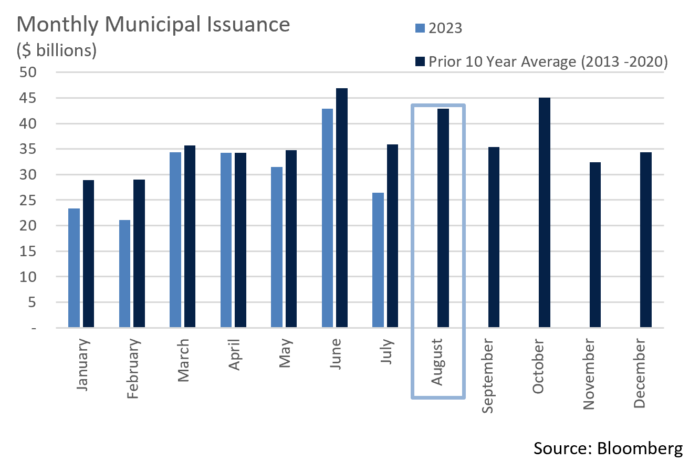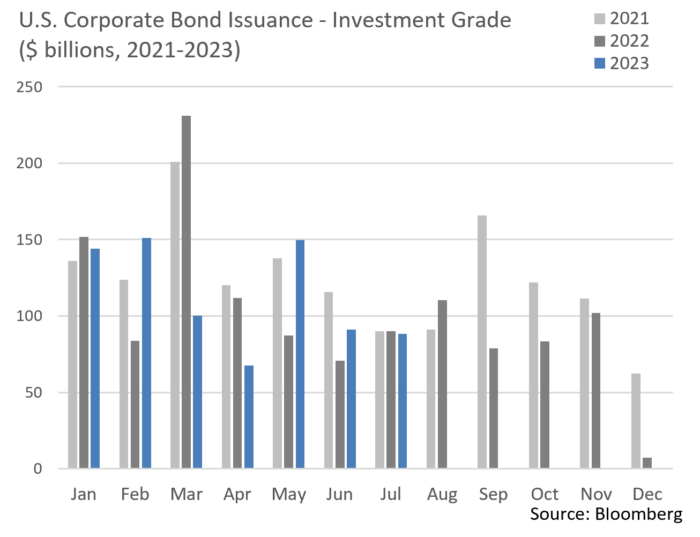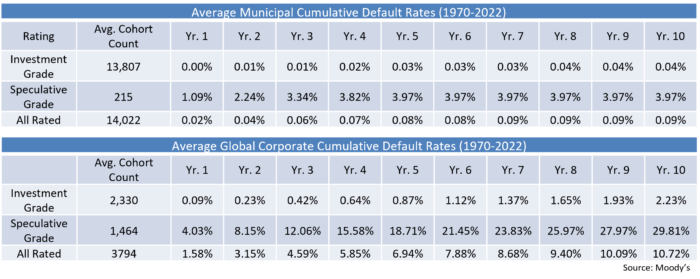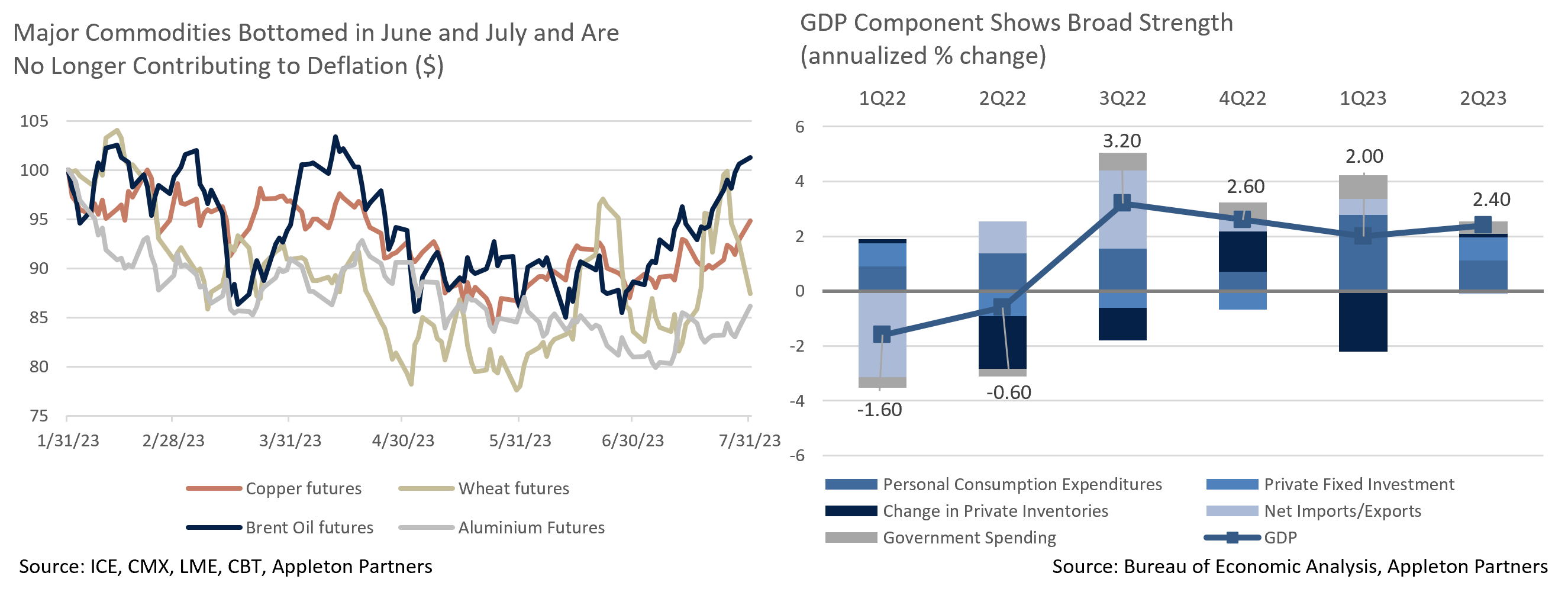Insights and Observations
Economic, Public Policy, and Fed Developments
- While one month does not make a trend, July was a very good one for US economic releases and the Federal Reserve’s fight against inflation. Both CPI and PCE both showed improvement, with the headline CPI and PCE garnering much attention for falling to +3.0%, just above the Fed’s +2% annual target. Markets were ebullient.
- Q2 GDP followed suit, coming in at +2.4% vs. consensus expectations of +1.8%. The list of underlying components showing strength was broad. Notably, final sales to private domestic purchasers tracked the headline closely at +2.3%, implying robust underlying demand. The PCE price deflator was also milder than expected, with core two-tenths below expectations at +3.8%. While this is still too high for the Fed, in many ways the release felt like a Goldilocks report after two years of flirting with stagflation.
- But, this is the crux of the problem; inflation may have moderated, but not for sustainable reasons, and not by enough. Much of the improvement in headline has been the combination of favorable base effects, which are now behind us, and falling commodity prices, which appear to have bottomed out over the past two months and are now rising. Core is still too high, with CPI at +4.8% and PCE at +4.1%, and progress to date has been slow. We expect headline inflation to start rising back towards core, absent a fundamental shift in consumer behavior.
- Fed Governor Chris Waller laid out a two-pronged argument in July on why the “long and variable lags” of monetary policy may be shorter than in years past and largely behind us. First, the Fed’s transparency around forward guidance led to markets beginning to tighten in advance of rate hikes, and second, with the speed at which rates were hiked, in 50 and 75bp increments, households and businesses were forced to respond faster to changing credit conditions. This is a credible argument and another reason why we expect further hikes will be necessary.
- In his July press conference, Powell remained carefully noncommittal on rate policy, stressing that the Fed will remain data dependent as they assess a September decision. Markets interpreted that as favoring a skip and now assess the chance of hiking at only one-in-six. We think that may be misguided for two reasons; the Jackson Hole conference in August creates a natural skip in the Fed’s calendar anyway and, for the reasons discussed above, we expect inflation to reaccelerate.
- However, we also believe a cyclical peak of longer-term rates is near. The 10Yr UST has remained rangebound with only short deviations outside 3.50-4.00% for the past nine months, and short-term rate increases have recently led to greater curve inversion. With the market positioned for a Fed now on hold, a more aggressive Fed willing to risk recession to tame inflation suggests the next move in long rates is more likely downwards than upwards, on lower forward inflation and growth expectations.
- A risk we remain vigilant about is the prospect of substantial Chinese stimulus spending. The country’s growth continues to stall, with GDP falling to +0.8% for the quarter and +6.4% for the trailing 12-month period in the government’s official reporting. After a slate of mild rule tweaks intended to stimulate growth failed to impress markets, we think significant stimulus spending is a possibility, and would expect to see spillover inflationary impacts on the rest of the world economy.
- Fitch downgraded US long-term debt from AAA to AA+ on August 1st. While newsworthy, the US Treasury bond is still the safest and most liquid asset in the global financial system, and we do not expect to see much market impact. At the August 2nd close, yields were only modestly higher, with the 10Yr rising 5bps on a day that also saw a strong ADP jobs report.
From the Trading Desk
Municipal Markets
- Municipal bond performance was positive for July, and we are expecting that to continue during August. Negative net supply will most likely increase this month with $48 billion coming back to investors via maturities and a 30-day visible supply calendar of $13.6 billion. Of that anticipated supply, $11.3 billion is being issued during the first week of August. These technical factors, including 11 weeks of consistent positive fund flows, are keeping municipal ratios rich, with the 10-year Muni/UST yield ratio ending July at 65%, as compared to a 12-month moving average of 72%.
- As highlighted in the chart, August has been the third highest issuance month over the past 10 years. This year’s lack of new supply will likely change that trend and can be attributed to both the rising rate environment, as well as state and local governments maintaining significant federal aid left over from pandemic relief. Many municipalities and states without acute funding needs are holding off on issuing new debt. Accordingly, overall YTD issuance is down 16% from the same period of 2022, a dynamic that has bolstered secondary market pricing and created oversubscription of most primary market offerings.
- Yields were more volatile towards the end of July in anticipation of a Fed decision to raise rates again. Over the course of the month, the front end of the curve saw yields rise between 6 and 12bps, while the belly to long-end of the curve was up only 1 – 3bps, exacerbating a highly atypical tax-exempt curve inversion. Municipals were slower to react after the July Fed meeting than Treasuries, in large part given favorable market technical factors.
- We are finding opportunities in 9 to 12-year maturities, the longer portion of our intermediate buying range, as front-end ratios have dipped below 60%. Curve inversion has also prompted us to complement relatively high short yields with some longer issues as a means of maintaining duration targets in our intermediate portfolios. A sluggish new issuance calendar increases the need to seek attractive relative value in the secondary market.

Corporate Bond Markets
- Fund flows remained strong over the month of July. Through the 26th, Lipper reported that US IG Corporate mutual funds had experienced 8 consecutive weeks of inflows totaling $13.1 billion. Investor appetite for high grade corporate credit has strengthened with a slate of strong economic data greatly reducing market fears of a US recession, at least for the time being.
- Issuers have responded to improving sentiment and sustained demand. July issuance was stronger than expected, as the more than $88 billion of new deals pricing comfortably exceeded initial dealer expectations of $75 billion. Issuance had been at risk of missing expectations before $19.5 billion priced on the last day of the month, right after a strong GDP print. This represents the largest single day of issuance since June.
- Regulators unveiled sweeping new capital rules for banks with assets over $100 billion at the end of July, to align US regulation with the international Basel III rules. The rules would result in an estimated 16% increase in regulatory capital, while forcing banks to carry high quality liquid assets at market value rather than book value when calculating capital ratios (currently only a requirement for institutions over $250 billion). The majority of banks assessed already have adequate capital to meet these new requirements but would have higher barriers to distributing capital to shareholders. From a bondholder perspective, we see this development as positive, even though the rules would likely weigh somewhat on profitability. If adopted, a three-year transition period would begin on July 1, 2025.

Public Sector Watch
Credit Comments
Municipal Defaults Remain Rare
- Moody’s released their annual Public Finance Default Study covering trends from 1970 – 2022 and reported only one default in 2022, reflecting the strength and resiliency of the municipal market. Municipal credit strength is derived from generally prudent fiscal management leading up to and during the pandemic, along with high levels of federal aid.
- The one default in 2022 was the NCCD – College Station Student Housing, which faced significant competition from other housing developments in the area, and experienced low occupancy rates and below anticipated rental revenue.
- Notably, the default was unrelated to the pandemic as the housing project had been relying on reserves to make payments since 2018. In fact, very few municipal defaults have been a direct result of the pandemic. For sectors such as senior living, many systems faced pre-existing financial challenges that were merely exacerbated by the pandemic.
- A more common pandemic impact relates to sudden unexpected revenue declines. Credits that were most affected tend to have a high percentage of tourist related revenue, although most entities saw very rapid recoveries, thereby avoiding long-term credit implications.
- Despite increased pandemic induced volatility, the average 5-year cumulative default rate from 2013 to 2022 of 0.08% remained in line with historical norms dating back to 1970.
- Municipal credits posted lower or very similar average cumulative default rates across all time horizons and rating categories over the study period from 1970 to the present as compared to global corporates. The aforementioned 5-year municipal cumulative default rate of only 0.08% compares to 6.94% for corporates.

Municipal Ratings Stability Has Been Sustained
- Another important dynamic closely followed by analysts is ratings stability, as downgrades and upgrades impact credit spreads and bond pricing.
- Credit quality in the municipal market has largely stabilized more than a decade after the Great Recession. Ratings volatility fell in 2022 and has remained significantly lower than global corporates. Additionally, in 2022 there were more rating upgrades than downgrades.
- Moody’s measures upgrade to downgrade ratios through rating drifts, a metric that captures an average of upgraded ratings notches per credit minus downgraded notches per credit. Aggregate municipal ratings strengthened in 2022, with drift moving up 2.4 notches per 100 credits, whereas corporate ratings drift was -8.7 notches per 100 credits. Over the entire study period dating back to 1970, municipal ratings drift has also remained very strong compared to global corporates.
- A very strong multi-decade track record of municipal rating stability and low default rates highlights the resiliency and strength of tax-exempt credit fundamentals.
Strategy Overview
Composite Portfolio Positioning as of 7/31/2023

Duration Exposure as of 7/31/2023

The composites used to calculate strategy characteristics (“Characteristic Composites”) are subsets of the account groups used to calculate strategy performance (“Performance Composites”). Characteristic Composites excludes any account in the Performance Composite where cash exceeds 10% of the portfolio. Therefore, Characteristic Composites can be a smaller subset of accounts than Performance Composites. Inclusion of the additional accounts in the Characteristic Composites would likely alter the characteristics displayed above by the excess cash. Please contact us if you would like to see characteristics of Appleton’s Performance Composites.
Our Philosophy and Process
- Our objective is to preserve and grow your clients’ capital in a tax efficient manner.
- Dynamic active management and an emphasis on liquidity affords us the flexibility to react to changes in the credit, interest rate and yield curve environments.
- Dissecting the yield curve to target maturity exposure can help us capture value and capitalize on market inefficiencies as rate cycles change.
- Customized separate accounts are structured to meet your clients’ evolving tax, liquidity, risk tolerance and other unique needs.
- Intense credit research is applied within the liquid, high investment grade universe.
- Extensive fundamental, technical and economic analysis is utilized in making investment decisions.





